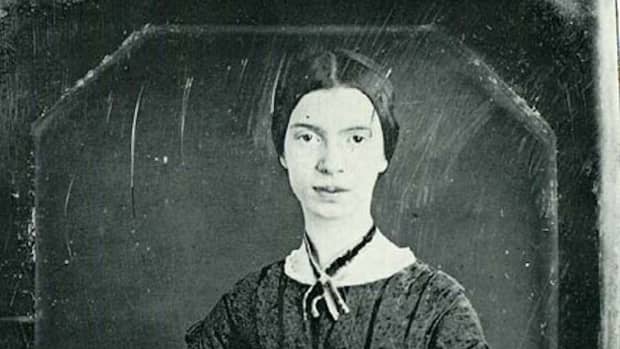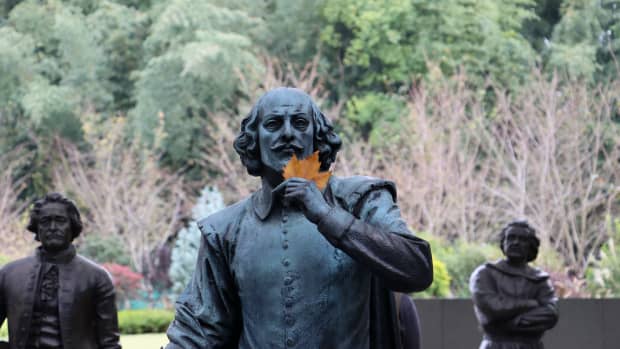Shakespeare’s 'Sonnet 60': Line-by-Line Analysis
'Sonnet 60'
Like as the waves make towards the pebbled shore,
So do our minutes hasten to their end,
Each changing place with that which goes before,
In sequent toil all forwards do contend.
Nativity once in the main of light,
Crawls to maturity, wherewith being crowned,
Crooked eclipses ’gainst his glory fight,
And Time that gave, doth now his gift confound.
Time doth transfix the flourish set on youth,
And delves the parallels in beauty’s brow,
Feeds on the rarities of nature’s truth,
And nothing stands but for his scythe to mow.
And yet to times in hope, my verse shall stand
Praising thy worth, despite his cruel hand.
William Shakespeare and a Summary of 'Sonnet 60'
'Sonnet 60' is one of several Shakespearean sonnets dealing with the effects of time on youth and beauty. Time is seen as cruel and confusing, giving new life but also taking it and, in the process, destroying youthful beauty. In the end, hopefully, the one thing that can stand against time is the speaker's verse.
Metaphors and symbols play important roles in this sonnet, and there are allusions to the bible and Greek mythology. Other devices include personification and simile.
Typically, the three quatrains (lines 1 - 12) represent the problem, whilst the solution or turn occurs in the end couplet.
What is unusual about sonnet 60 is that each quatrain offers a different perspective on the nature of time and how it affects the human condition. So it is that the reader is introduced to the tidal ocean, the wheeling cosmos and the symbolic scythe - all interweaving and measuring out our span on Earth.
Yes, it is painful to experience the ravages of time, and this sonnet delves deep, but there is always a glimmer of hope. Love and poetry can help offset the extremes of time and, ultimately, death.
Time and its role in Elizabethan society was an all-important subject when Shakespeare was alive. Astrology was still popular and not deemed a mere superstition, so the orbits of the planets and such events as eclipses were viewed in awe and, often, dread anticipation.
Timing of events and happenings in one's personal life was taken seriously, as was the idea that malignant forces would play their part if the heavens so dictated.
Shakespeare's 'Sonnet 60' captures the essence of what cruel time could do to 'beauty's brow' - like some magic potion, the sonnet alone will preserve it for future times. How true.
When Was 'Sonnet 60' Written?
Sonnet 60 was published in a quarto in 1609. This publication, titled Shake-speare's Sonnets, features 154 sonnets that cover many themes, such as the passage of time, mortality, beauty and love.
Analysis of 'Sonnet 60'
An unusual opening line introduces a simple simile to the reader and a common enough image to the eye: waves approaching the shore, repeatedly forming. But this shoreline is pebbled, so no sands of time here. How come?
Well, this could be an allusion to Greek mythology and the River Styx, where pebbles represent all of those deceased, gone to the hereafter. So this is no sandy beach but one of small symbolic stones.
And a parallel is made with time, our time, split into minutes for 60 good reasons. Like the waves, our minutes are rushing to some ineluctable end. As they one by one disappear, it's as if each minute, this tide of time, replaces itself, working hard in an unbroken series.
First Quatrain
- Note how each line of the first quatrain matches this idea of continuous motion, each line changing place with the one that's gone before, a repeat of the natural physics.
- Although iambic pentameter is the steadying rhythm which helps relate time to wave, trochee and spondee convey the sudden crash of the wave, breaking up the natural pattern.
This connection to the ocean, to water, continues. Birth is seen as occurring in a sea of light (main - sea). It's a powerful, uplifting image, implying a solar influence, whilst the idea that a human crawls to maturity is a darker personification.
And as we reach our peak, are crowned in the manner of a king or queen, or perhaps Christ himself, malignant cosmic forces act against us. Time is seen as both a generous benefactor and a shadowy spoiler; it confusingly gives then takes away.
Second Quatrain
- This second quatrain offers a different angle on the nature of time. Time is becoming more complex and cosmic. No longer is the speaker dealing in minutes, clocktime, but in the orbits and behaviour of the planets and stars.
- Note how lines 6 and 7 open with trochees, whilst line 8 settles everything down again with perfect iambic pentameter.
Third Quatrain
Having related minutes to ocean waves and life to a cosmic event, both abstractions, the reader is now faced with the manifestation of time on an initially youthful human face. This is reality calling.
Transfix is to pierce with something sharp, hence time is a pointed, cutting edge that destroys beauty by affecting the flesh; and delve is to dig, hence time as a crude implement wrinkling the brow (parallels are military trenches). All of this suggests a painful experience at the hands of time.
Further personification sees time feeding on even the most valued natural beauty. Time is like a parasite, a hungry thing - it will cut down everything in the end.
- Time and tide wait for no man. Minutes pass, oceans move, the orbits continue and the human can do little to withstand the effects. The clock is ticking, and as it does so, it takes away our youth and beauty.
- Note some of the vocabulary of the three quatrains: toil, crawl, crooked, 'gainst, confound, transfix, delves, feeds, scythe, mow - there is much struggle and possible pain.
- The scythe belongs to the Grim Reaper, aka Kronos, Lord of Time. In Shakespeare's age, the scythe was a powerful symbol, as well as a vital agricultural tool.
End Couplet
So to the end couplet and the turn or solution. The speaker is hopeful, only hopeful, that his verse shall stand in defiance of time and sustain the praise his lover deserves. Whatever time throws at us, poetry is the one thing that can preserve beauty's truth.
Literary Techniques in 'Sonnet 60'
'Sonnet 60' is a Shakespearean or English sonnet consisting of three quatrains and a couplet. The quatrains make up what is sometimes called the problem or issue, and the couplet is a solution to the problem, the turn (or volta), a conclusive kind of 'rescue' drawn from what's gone before.
Rhyme
The rhyme scheme is typical of this sonnet: ababcdcdefefgg.
All of these end rhymes are full except for lines 10 and 12, brow/mow, which is pararhyme. The full rhymes tend to bring familiar closure, even harmony, to proceedings.
Metrical Analysis
Whilst the majority of this sonnet is written in iambic pentameter, da-DUM, da-DUM, da-DUM, da-DUM, da-DUM, with a stressed syllable following a non-stressed syllable, certain changes in metre (meter in USA) demand our attention.
Line 1
- Like as / the waves / make towards / the peb / bled shore,
Here there is an opening trochee (inverted iamb), plus one in the middle of the line, which echo the sound of the crashing wave on the shoreline. Then comes the steady rhythm of the other waves settling into iambic mode.
Line 2
- So do our minutes hasten to their end,
Likewise, the second line starts with a trochee, a sudden stress representing the wave crash, before the iambic rhythm steadies the line.
Line 3
- Each chan / ging place with that which goes before,
And the third line also has a trochee to place emphasis on this repeated crashing of the waves. Iambs follow.
Line 4
- In se / quent toil / all for / wards do contend.
Note the spondee in the middle of the line which changes the rhythm, unsettling the iambics on either side.
Several other lines have this opening trochee, bringing interest and altered rhythm into the sonnet. Other lines are completely classic iambic pentameter.
End Couplet
- And yet / to times / in hope / my verse / shall stand,
- Praising / thy worth, / despite / his cru / el hand.
Classic iambic pentameter for line 13, an opening trochee for the last line, with stress on the first syllable.
What Is the Role of Time in 'Sonnet 60'
The ruthless and consistent passing of time is the main theme of the poem. The first quatrain compares the constant passing of minutes to the unrelenting waves that continuously crash on the shore. As each wave replaces its predecessor, so does our present replace our past.
Time is presented in a dual role of benefactor and eventual destroyer. It offers maturity to youth, but it continues its cycle to an eventual demise. Times seemingly creates beauty only to later feed on it.
The third quatrain then personifies time as death itself with the imagery of its scythe. It also seems to be personified as a violent figure attacking youth and life itself. Time is seen as an antagonistic force here, and there is no definite way to overcome time. Only the poem surviving the ages can offer a mere consolation prize in combating the steady march of time.
Source
- www.poetryfoundation.org
- www.bl.uk
- www.jstor.org
© 2017 Andrew Spacey








